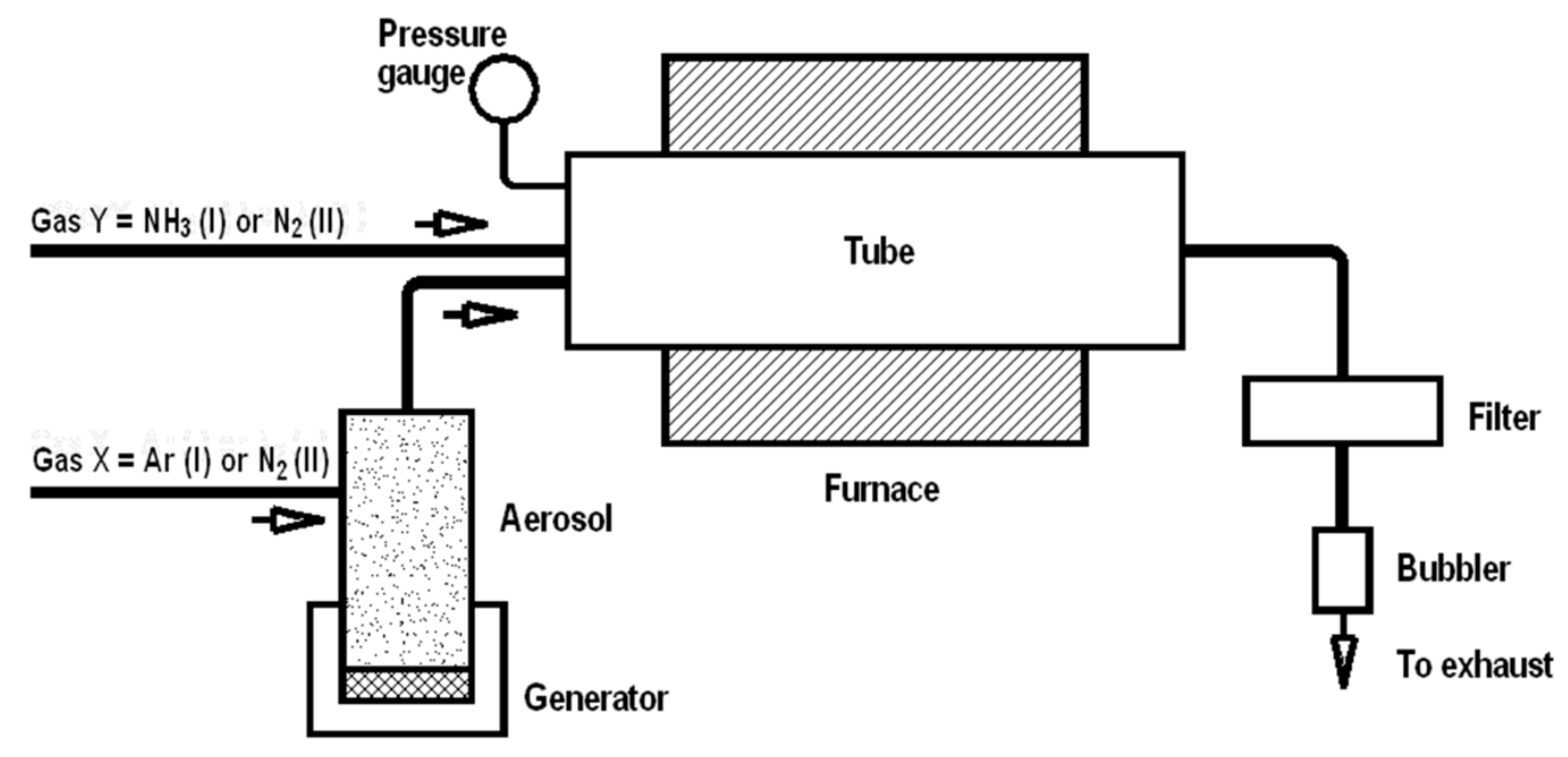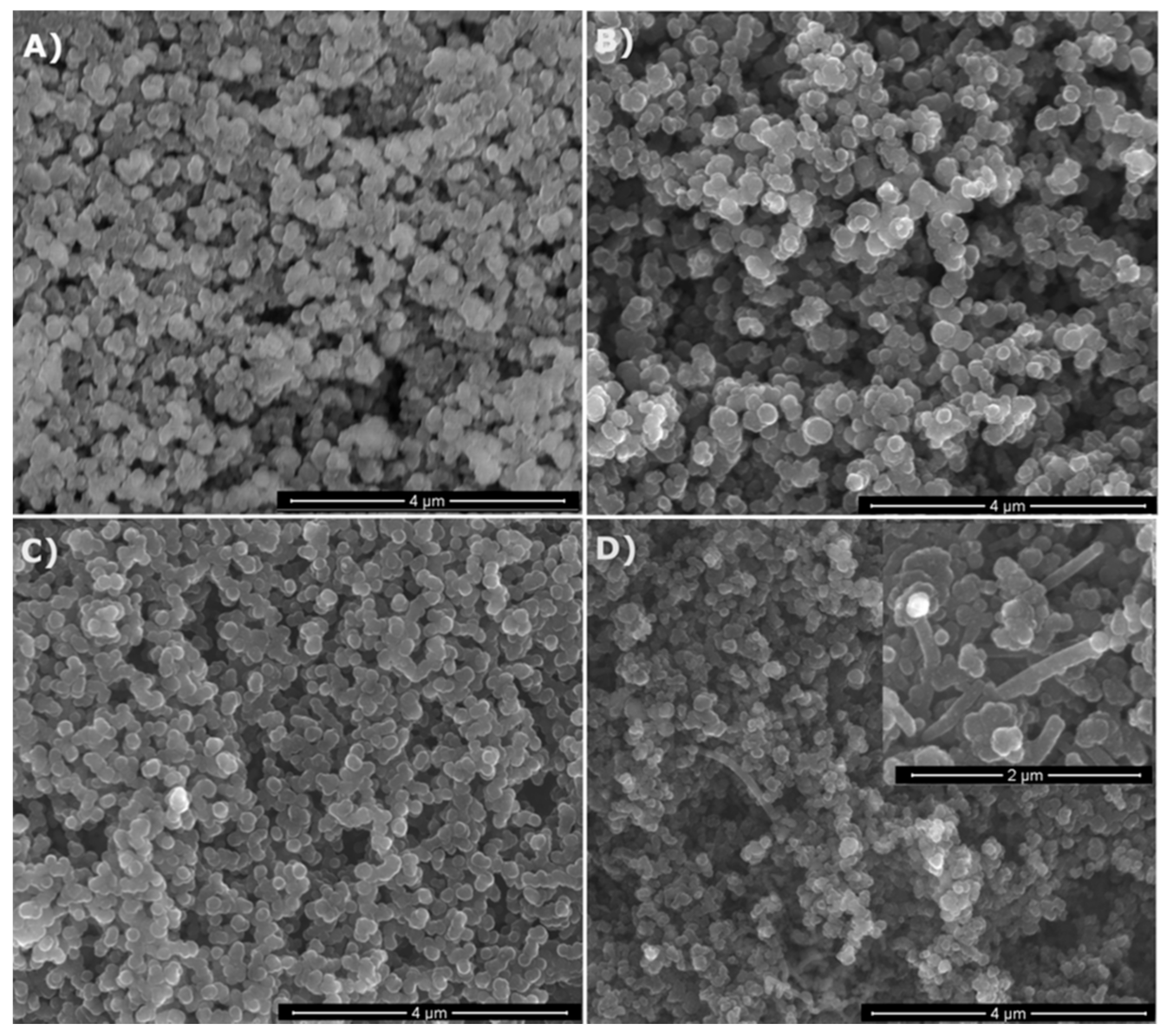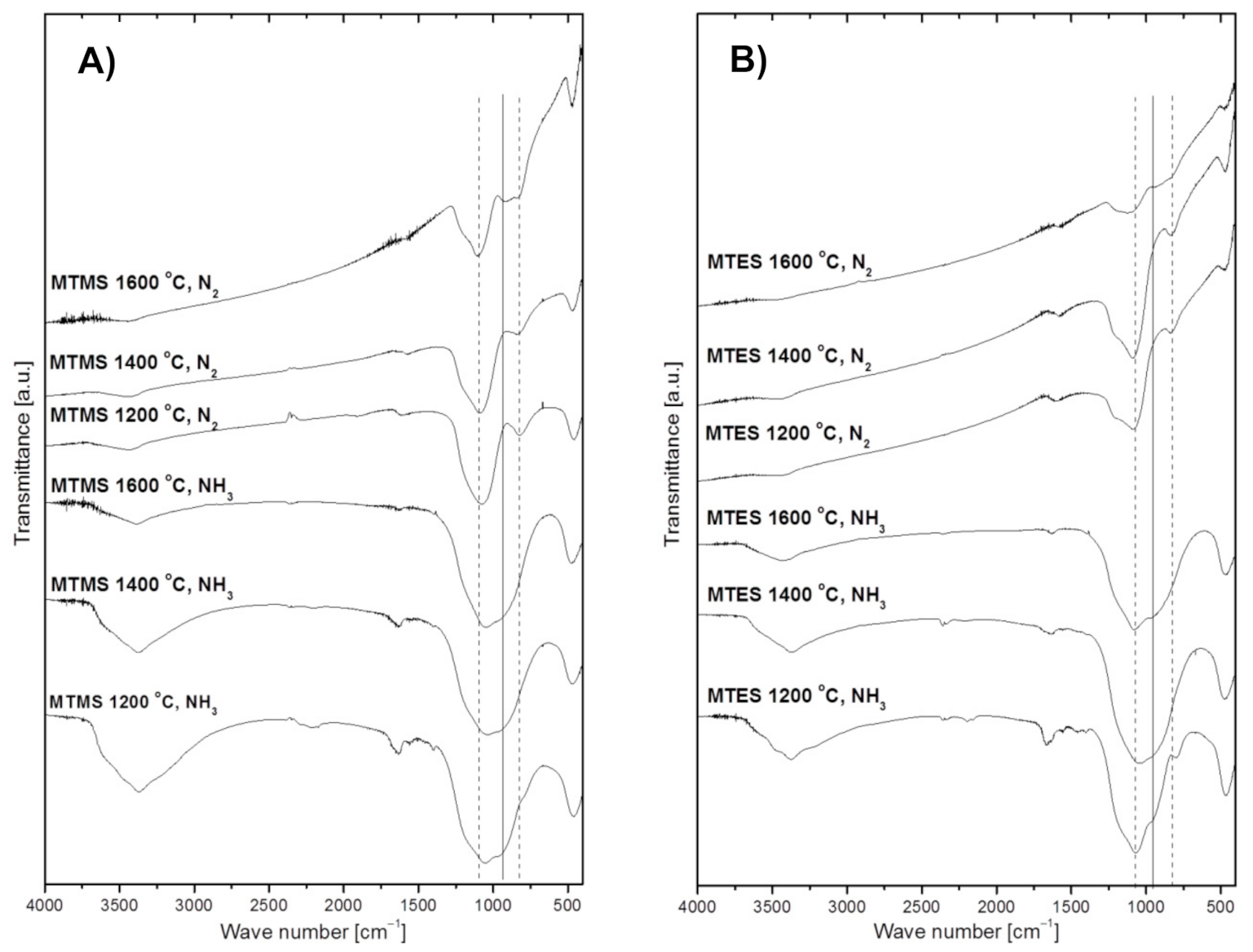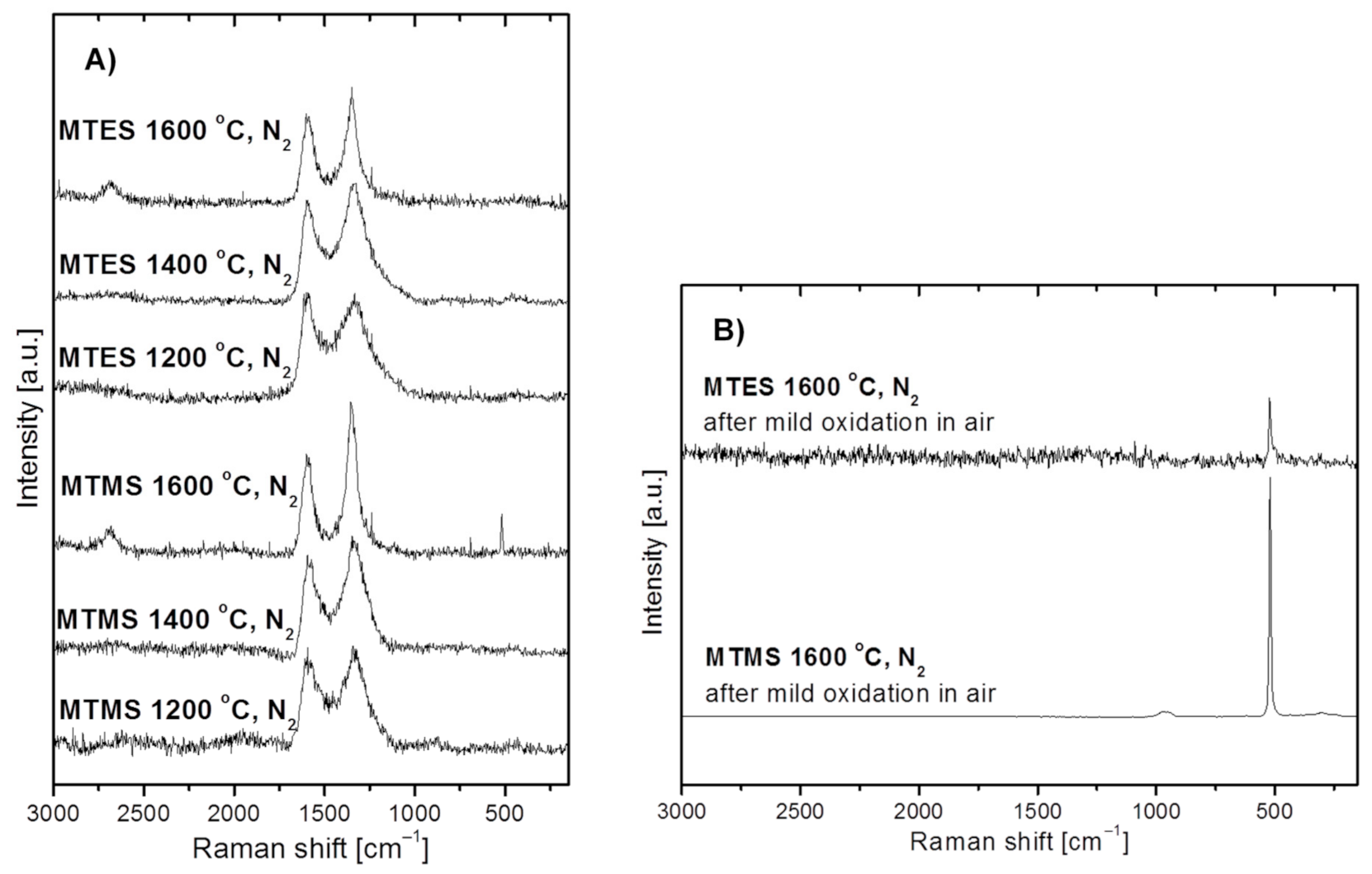Amorphous Silicon Oxynitride-Based Powders Produced by Spray Pyrolysis from Liquid Organosilicon Compounds
Abstract
:1. Introduction
2. Materials and Methods
3. Results and Discussion
4. Conclusions
Author Contributions
Funding
Institutional Review Board Statement
Informed Consent Statement
Data Availability Statement
Conflicts of Interest
References
- Khader, I.; Koplin, C.; Schröder, C.; Stockmann, J.; Beckert, W.; Kunz, W.; Kailer, A. Characterization of a silicon nitride ceramic material for ceramic springs. J. Eur. Ceram. Soc. 2020, 40, 3541–3554. [Google Scholar] [CrossRef]
- Badran, Z.; Struillou, X.; Hughes, F.J.; Soueidan, A.; Hoornaert, A.; Ide, M. Silicon nitride (Si3N4) implants: The future of dental implantology? J. Oral. Implantol. 2017, 43, 240–244. [Google Scholar] [CrossRef] [PubMed] [Green Version]
- Rahaman, M.; Xiao, W. Silicon nitride bioceramics in healthcare. Int. J. Appl. Ceram. Technol. 2018, 15, 861–872. [Google Scholar] [CrossRef]
- Sakka, S. Oxynitride glasses. Ann. Rev. Mater. Sci. 1986, 16, 29–46. [Google Scholar] [CrossRef]
- Bickmore, C.R.; Laine, R. Synthesis of oxynitride powders via fluidized-bed ammonolysis, Part I: Large, porous, silica particles. J. Am. Ceram. Soc. 1996, 79, 2865–2877. [Google Scholar] [CrossRef] [Green Version]
- Hampshire, S.; Drew, R.A.; Jack, K.H. Oxynitride glasses. Phys. Chem. Glasses 1985, 26, 182–186. [Google Scholar]
- Garcia, Á.R.; Clausell, C.; Barba, A. Oxynitride glasses: A review. Bol. Soc. Esp. Ceram. Vidr. 2016, 55, 209–218. [Google Scholar] [CrossRef] [Green Version]
- Ali, S.; Jonson, B.; Pomeroy, M.J.; Hampshire, S. Issues associated with the development of transparent oxynitride glasses. Ceram. Int. 2015, 41, 3345–3354. [Google Scholar] [CrossRef]
- Hampshire, S.; Pomeroy, M.J. Oxynitride glasses. Int. J. Appl. Ceram. Technol. 2008, 5, 155–163. [Google Scholar] [CrossRef]
- Hakeem, A.S.; Dauce, R.; Leonova, E.; Eden, M.; Shen, Z.J.; Grins, J.; Esmaeilzadeh, S. Silicate glasses with unprecedented high nitrogen and electropositive metal contents obtained by using metals as precursors. Adv. Mater. 2005, 17, 2214–2216. [Google Scholar] [CrossRef]
- Li, X.; Zhang, L.; Yin, X. Study on in-situ reaction synthesis and mechanical properties of Si2N2O ceramic. Ceram. Int. 2013, 39, 3035–3041. [Google Scholar] [CrossRef]
- Wu, S.; Li, X. In-situ reactive synthesis of Si2N2O ceramics and its properties. Metall. Mater. Trans. 2012, A43, 4859–4865. [Google Scholar] [CrossRef]
- Wu, S.; Li, X. Preparation of pure nano-grained Si2N2O ceramic. Int. J. Refract. Met. Hard Mater. 2013, 36, 97–100. [Google Scholar] [CrossRef]
- Bergman, B.; Heping, H. The influence of different oxides on the formation of Si2N2O from SiO2 and Si3N4. J. Eur. Ceram. Soc. 1990, 6, 3–8. [Google Scholar] [CrossRef]
- Fruhstorfer, J.; Kerber, F.; Weigelt, C.; Moritz, K.; Aneziris, C.G. Activated reaction synthesis of silicon oxynitride from silica and silicon nitride. Ceram. Int. 2018, 44, 8467–8475. [Google Scholar] [CrossRef]
- Sitarz, M.; Czosnek, C.; Jelen, P.; Odziomek, M.; Olejniczak, Z.; Kozanecki, M.; Janik, J.F. SiOC glasses produced from silsesquioxanes by the aerosol-assisted vapor synthesis method. Spectrochim. Acta A 2013, 112, 440–445. [Google Scholar] [CrossRef]
- Czosnek, C.; Janik, J.F. Particle morphology of various SiC-based nanocomposite powders made by the aerosol-assisted synthesis method. J. Nanosci. Nanotechnol. 2008, 8, 907–913. [Google Scholar] [CrossRef]
- Czosnek, C.; Kluska, S.; Janik, J.F. Aerosol-assisted synthesis of SiC-based nanopowders from organosilicon precursor systems. Mater. Sci. Pol. 2008, 26, 309–318. [Google Scholar]
- Czosnek, C.; Bucko, M.M.; Janik, J.F.; Olejniczak, Z.; Bystrzejewski, M.; Łabędź, O.; Huczko, A. Preparation of silicon carbide SiC-based nanopowders by the aerosol-assisted synthesis and the DC thermal plasma synthesis methods. Mater. Res. Bull. 2015, 63, 164–172. [Google Scholar] [CrossRef]
- Czosnek, C.; Janik, J.F. Nanopowder silicon carbide and carbon/silicon carbide composites prepared by the aerosol-assisted synthesis. Przem. Chem. 2014, 93, 2020–2024. [Google Scholar]
- Li, F.J.; Wakihara, T.; Tatami, J.; Komeya, K.; Meguro, T. Synthesis of β-SiAlON powder by carbothermal reduction-nitridation of zeolites with different compositions. J. Eur. Ceram. Soc. 2007, 27, 2535–2540. [Google Scholar] [CrossRef]
- van Dijen, F.K.; Pluijmakers, J. The removal of carbon or carbon residues from ceramic powders or greenware with ammonia. J. Eur. Ceram. Soc. 1989, 5, 385–390. [Google Scholar] [CrossRef]
- Shang, H.; Lu, Y.; Zhao, F.; Chao, C.; Zhang, B.; Zhang, H. Preparing high surface area porous carbon from biomass by carbonization in a molten salt medium. RSC Adv. 2015, 5, 75728–75734. [Google Scholar] [CrossRef]
- Chen, X.; Jiang, J.; Yan, F.; Tian, S.; Lia, K. A novel low temperature vapor phase hydrolysis method for the production of nano-structured silica materials using silicon tetrachloride. RSC Adv. 2014, 4, 8703–8710. [Google Scholar] [CrossRef]
- Zulfiqar, U.; Subhani, T.; Husain, S.W. Synthesis and characterization of silica nanoparticles from clay. J. Asian Ceram. Soc. 2016, 4, 91–96. [Google Scholar] [CrossRef]
- Krasovskii, P.V.; Samokhin, A.V.; Kirpichev, D.E.; Sigalaev, S.K.; Sirotinkin, V.P. Carbon forms, carbide yield and impurity-driven nonstoichiometry of plasma-generated β-silicon carbide nanopowders. Mater. Chem. Phys. 2020, 253, 123077. [Google Scholar] [CrossRef]
- Pujar, V.V.; Cawley, J.D. Computer simulations of diffraction effects due to stacking faults in β-SiC: II, Experimental verification. J. Am. Ceram. Soc. 2001, 84, 2645–2651. [Google Scholar] [CrossRef]
- Grabowska, B.; Sitarz, M.; Olejnik, E.; Kaczmarska, K. FT-IR and FT-Raman studies of cross-linking processes with Ca2+ ions, glutaraldehyde and microwave radiation for polymer composition of poly(acrylic acid)/sodium salt of carboxymethyl starch—Part I. Spectrochim. Acta Part A 2015, 135, 529–535. [Google Scholar] [CrossRef]
- Grabowska, B.; Sitarz, M.; Olejnik, E.; Kaczmarska, K. FT-IR and FT-Raman studies of cross-linking processes with Ca2+ ions, glutaraldehyde and microwave radiation for polymer composition of poly(acrylic acid)/sodium salt of carboxymethyl starch—In moulding sands, Part II. Spectrochim. Acta Part A 2015, 151, 27–33. [Google Scholar] [CrossRef]
- Sitarz, M. The structure of simple silicate glasses in the light of Middle Infrared spectroscopy studies. J. Non-Cryst. Solids 2011, 357, 1603–1608. [Google Scholar] [CrossRef]
- Fan, J.Y.; Li, H.X.; Cui, W.N. Microstructure and infrared spectral properties of porous polycrystalline and nanocrystalline cubic silicon carbide. Appl. Phys. Lett. 2009, 95, 021906. [Google Scholar] [CrossRef]
- Sitarz, M.; Jastrzębski, W.; Jeleń, P.; Długoń, E.; Gawęda, M. Preparation and structural studies of black glasses based on ladder-like silsesquioxanes. Spectrochim. Acta Part A 2014, 132, 884–888. [Google Scholar] [CrossRef] [PubMed]
- Bik, M.; Jeleń, P.; Długoń, E.; Bik, E.; Mroczka, K.; Barańska, M.; Sitarz, M. SiAlOC glasses derived from sol-gel synthesized ladder-like silsesquioxanes. Ceram. Int. 2019, 45, 1683–1690. [Google Scholar] [CrossRef]
- Jelen, P.; Szumera, M.; Gaweda, M.; Długoń, E.; Sitarz, M. Thermal evolution of ladder-like silsesquioxanes during formation of black glasses. J. Therm. Anal. Calorim. 2017, 130, 103–111. [Google Scholar] [CrossRef] [Green Version]
- Handke, M.; Sitarz, M.; Długoń, E. Amorphous SiCxOy coatings from ladder-like polysilsesquioxanes. J. Mol. Struct. 2011, 993, 193–197. [Google Scholar] [CrossRef]
- Viard, J.; Beche, E.; Perarnau, D.; Berjoran, R.; Durand, J. XPS and FTIR study of silicon oxynitride thin films. J. Eur. Ceram. Soc. 1997, 17, 2025–2028. [Google Scholar] [CrossRef]
- Cross, T.J.; Raj, R.; Prasad, S.V.; Tallant, D.R. Synthesis and tribological behavior of silicon oxycarbonitride thin films derived from poly(urea) methyl vinyl silazane. Int. J. Appl. Ceram. Technol. 2006, 3, 113–126. [Google Scholar] [CrossRef]
- Muñoz, F.; Benne, D.; Pascual, L.; Rocherullé, J.; Marchand, R.; Rűssel, C.; Durán, A. Silicon oxynitride glasses produced by ammonolysis from colloidal silica. J. Non-Cryst. Solids 2004, 345–346, 647–652. [Google Scholar]
- Wong, C.K.; Wong, H.; Kok, C.W.; Chan, M. Silicon oxynitride prepared by chemical vapor deposition as optical waveguide materials. J. Cryst. Growth 2006, 288, 171–175. [Google Scholar] [CrossRef]
- Tuinstra, F.; Koenig, J.L. Raman spectrum of graphite. J. Chem. Phys. 1970, 53, 1126–1130. [Google Scholar] [CrossRef] [Green Version]
- Costa, S.; Borowiak-Palen, E.; Kruszyńska, M.; Bachmatiuk, A.; Kaleńczuk, R.J. Characterization of carbon nanotubes by Raman spectroscopy. Mater. Sci. Pol. 2008, 26, 433–441. [Google Scholar]
- Yapuchura, E.R.; Tartaglia, R.S.; Cunha, A.G.; Freitas, J.C.C.; Emmerich, F.G. Observation of the transformation of silica phytoliths into SiC and SiO2 particles in biomass-derived carbons by using SEM/EDS, Raman spectroscopy, and XRD. J. Mater. Sci. 2019, 54, 3761–3777. [Google Scholar] [CrossRef]
- Czosnek, C.; Baran, P.; Grzywacz, P.; Baran, P.; Janik, J.F.; Różycka, A.; Sitarz, M.; Jeleń, P. Generation of carbon nanostructures with diverse morphologies by the catalytic aerosol-assisted vapor-phase synthesis method. Comptes Rendus Chim. 2015, 18, 1198–1204. [Google Scholar] [CrossRef]
- Bik, M.; Szewczyk, J.; Jeleń, P.; Długoń, E.; Simka, W.; Sowa, M.; Tyczkowski, J.; Balcerzak, J.; Bik, E.; Mroczka, K.; et al. Optimization of the formation of coatings based on SiAlOC glasses via structural, microstructural and electrochemical studies. Electrochim. Acta 2019, 309, 44–56. [Google Scholar] [CrossRef]
- Bik, M.; Stygar, M.; Jeleń, P.; Dąbrowa, J.; Leśniak, M.; Brylewski, T.; Sitarz, M. Protective-conducting coatings based on black glasses (SiOC) for application in Solid Oxide Fuel Cells. Int. J. Hydrog. Energy 2017, 42, 27298–27307. [Google Scholar] [CrossRef]
- Jeleń, P.; Bik, M.; Nocuń, M.; Gawęda, M.; Długoń, E.; Sitarz, M. Free carbon phase in SiOC glasses derived from ladder-like silsesquioxanes. J. Mol. Struct. 2016, 1126, 172–176. [Google Scholar] [CrossRef]
- Karlin, S.; Colomban, P.H. Raman study of the chemical and thermal degradation of as-received and sol-gel embedded Nicalon and Hi-Nicalon SiC fibres used in ceramic matrix composites. J. Raman Spectrosc. 1997, 28, 219–228. [Google Scholar] [CrossRef]
- Colomban, P.; Gouadec, G.; Mazerolles, L. Raman analysis of materials corrosion: The example of SiC fibers. Mater. Corros. 2002, 53, 306–315. [Google Scholar] [CrossRef]
- Sui, Z.; Leong, P.P.; Herman, I.P.; Higashi, G.S.; Temkin, H. Raman analysis of light-emitting porous silicon. Appl. Phys. Lett. 1992, 60, 2086–2088. [Google Scholar] [CrossRef]
- Voutsasa, A.T.; Hatalis, M.K.; Boyce, J.; Chiang, A. Raman spectroscopy of amorphous and microcrystalline silicon films deposited by low-pressure chemical vapor deposition. J. Appl. Phys. 1995, 78, 6999–7006. [Google Scholar] [CrossRef]





| Precursor | Gas Atmosphere | Temperature [°C] | O Content [wt %] | N Content [wt %] | O/N [at %/at %] | C Free [wt %] |
|---|---|---|---|---|---|---|
| MTMS | NH3 | 1200 | 39.1 | 14.7 | 2.3 | <1 |
| 1400 | 33.6 | 18.5 | 1.6 | <1 | ||
| 1600 | 26.0 | 19.3 | 1.2 | <1 | ||
| N2 | 1200 | 32.5 | 1.6 | 17.8 | 18.5 | |
| 1400 | 24.4 | 1.5 | 14.2 | 20.5 | ||
| 1600 | 16.1 | 2.9 | 4.9 | 21.4 | ||
| MTES | NH3 | 1200 | 39.0 | 13.4 | 2.5 | <1 |
| 1400 | 35.1 | 17.1 | 1.8 | <1 | ||
| 1600 | 32.9 | 15.7 | 1.8 | <1 | ||
| N2 | 1200 | 27.0 | 1.6 | 14.8 | 42.8 | |
| 1400 | 27.8 | 1.5 | 16.2 | 40.7 | ||
| 1600 | 10.7 | 2.5 | 3.7 | 51.0 |
Publisher’s Note: MDPI stays neutral with regard to jurisdictional claims in published maps and institutional affiliations. |
© 2021 by the authors. Licensee MDPI, Basel, Switzerland. This article is an open access article distributed under the terms and conditions of the Creative Commons Attribution (CC BY) license (http://creativecommons.org/licenses/by/4.0/).
Share and Cite
Osip, H.; Czosnek, C.; Janik, J.F.; Marchewka, J.; Sitarz, M. Amorphous Silicon Oxynitride-Based Powders Produced by Spray Pyrolysis from Liquid Organosilicon Compounds. Materials 2021, 14, 386. https://doi.org/10.3390/ma14020386
Osip H, Czosnek C, Janik JF, Marchewka J, Sitarz M. Amorphous Silicon Oxynitride-Based Powders Produced by Spray Pyrolysis from Liquid Organosilicon Compounds. Materials. 2021; 14(2):386. https://doi.org/10.3390/ma14020386
Chicago/Turabian StyleOsip, Honorata, Cezary Czosnek, Jerzy F. Janik, Jakub Marchewka, and Maciej Sitarz. 2021. "Amorphous Silicon Oxynitride-Based Powders Produced by Spray Pyrolysis from Liquid Organosilicon Compounds" Materials 14, no. 2: 386. https://doi.org/10.3390/ma14020386





